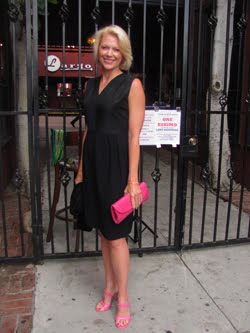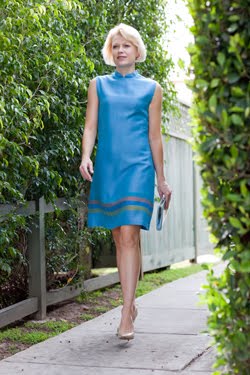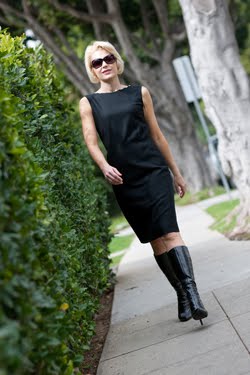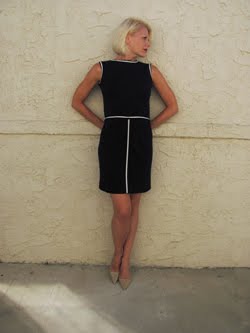Few films capture the feel of Hollywood better than director
Billy Wilder's
Sunset Boulevard (1950). Though much of the movie feels almost dreamlike (starting with voiceover narration that comes courtesy of a dead man), in many ways it couldn't be more real. Wilder wove fact in with fiction at every turn of the production--from its classic Los Angeles locations to the actors involved to its story of a fallen star. Even its costume design--with its deep history between costume designer
Edith Head and star
Gloria Swanson--adds to the surrealism. Costume design is always important in a film, but it is vital in
Sunset Boulevard. With it, Swanson transforms herself into Norma Desmond, one of the most iconic film characters of all time.
The realism in Sunset Boulevard starts with the actresses Wilder first considered to play the part of Norma Desmond. Mae West, Mary Pickford, and Pola Negri were all approached, but each were concerned that her life came a little too close to the character of a former, and now faded, star. In contrast, Gloria Swanson was very unlike the character--an energetic and savvy business woman who was always working. From her success in acting, she became a producer...one of the first women to finance her own productions. And from her success as a producer, she evolved into an entrepreneur. Most notably, this included fashion design and running an apparel company in New York.
Sunset Boulevard seems all the more real because of how much Gloria's real life intersects with those in the film. Even minor characters are familiar faces--silent screen stars Buster Keaton, H. B. Warner, and Anna Q. Nilsson make a group appearance at Norma's card game. Actress-turned-gossip columnist Hedda Hopper also makes a cameo at the end of the movie during Norma's demise. But it's two of her co-stars who have the deepest connection to Gloria--Erich Von Stroheim and
Cecil B. DeMille. Von Stroheim is cast as Max Von Mayerling, Norma's butler who was once her husband and movie director. Max is described in the film as one of the great directors of the silent era alongside D. W. Griffith and Cecil B. DeMille, which is certainly true of Von Stroheim. A clip of his
Queen Kelly (1929, starring Gloria Swanson) even makes an appearance in
Sunset Boulevard, which was the first time it was even seen by audiences. And of course DeMille could not have been a bigger part of Gloria's life and career. They made six movies together starting when she was only a teen and they turned Gloria into an international superstar.
DeMille called her the "movie star of all movie stars." Wilder has the character Max remind us that she "was the greatest star of them all." In her role as star, Gloria was the first clotheshorse in Hollywood, known for her high style onscreen as well as off. Her films with DeMille like
Why Change Your Wife? (1920) were known for the quality
and quantity of her costumes. In fact, he found fashion to be an integral part of his formula for success--"sex, sets, and costumes." Costume designers
Clare West and Mitchell Leisen dressed her in everything from European haute couture to their own custom-made clothes. Luxurious fabrics were loosely draped on Gloria's figure and accents like beading and feathers made her an Art Deco goddess. Audiences lined up again and again for her "fashion films" (as DeMille called them) and everyone wanted to be as glamorous as Gloria. She was so influential that it is largely her style we think of when we envision the early 1920s.

Furs--like this one made from 22 opossums in Her Husband's Trademark (1922, above)--
and feathers were a huge part of Gloria's 1920s onscreen style
as well as beading and headdresses galore as shown in this look from 1921 (below)
Two costumes from 1919's Male and Female--
an over-the-top gown made of fur with a chain-mail train (above)
and pearl dress with peacock headdress (below)
Gloria was already the queen of the movies, but in 1925 she flew to France and also married a Marquis (Henri de la Falaise de Coudray). There was global fanfare about the marriage that included parades in both New York and Los Angeles. Upon Gloria's return to Paramount, she passed through the gates in what Romans would call a triumph--the entire studio lined the streets and literally threw roses at the procession and then her feet when Gloria emerged from her Rolls Royce. The event became enough of Hollywood legend that Wilder seems to reference it in Sunset Boulevard when Joe Gillis (William Holden) describes Norma Desmond (Gloria Swanson) as a former star "still waving proudly to a parade that had long since passed her by."
Costume designer Edith Head was among the adoring employees who lined up to greet Gloria with petals in hand. The experience was one she never forgot. "In my mind, Gloria represented the greatest from the days when I was just a beginner," Edith said. "She was a legend when I was walking around with stars in my eyes." Edith had only started at Paramount two years earlier as a sketch artist and assistant to head costume designer Howard Greer. In contrast to Greer and colleague Travis Banton--who both came to Paramount from the Lucile couturier--Edith did not come from the world of fashion. Instead, she had a Masters degree in Romance Languages from Stanford, taught French and art at the Hollywood School for Girls (where DeMille's daughters went), and took art classes on the side. But for 15 years, she would learn everything there was to know about costume design from the masters of "Paramount Polish." They taught her about fabrics, design techniques, and the production process. She turned out to be a natural, and complimented the genius twosome by being particularly gifted at management and politics. When Edith started, Gloria was at her height of popularity and only worked with the best, which meant Banton and Greer. Edith's job was to wash her hosiery.

Edith in the 1920s during her first decade at Paramount (above)
and with Gloria Swanson around the time of Sunset Boulevard
Obviously, Edith relished the opportunity to now design for Gloria. "Dressing her meant dressing an idol," she remembered. Though at first she was anxious about working with the "meticulous" actress who was well versed in fashion--both Banton and Greer had mentioned her exacting nature--Edith found she already had an admirer in Gloria. After all, Edith had enjoyed great success since succeeding Banton as Paramount's head of costume design in 1938. This included contributing to style in
film noir that we now consider iconic. For instance, she created the costumes for Barbara Stanwyck in
Double Indemnity (1944) and other
noir like
The Strange Love of Martha Ivers (1946). She also helped create
Veronica Lake's look (as well as co-star Alan Ladd) in
This Gun for Hire (1942),
The Glass Key (1942), and
The Blue Dahlia (1946). Now she would help create another iconic
film noir character with Gloria in
Sunset Boulevard.
From the beginning of the production, everyone was clear about the character of Norma Desmond. Wilder described her saying,
Although her greatest moments were in her silent movie days, Norma Desmond tried to be as contemporary as possible by wearing fashionable styles, clothes, and makeup; yet there was something about her that connoted a sense of the past, a bit of deja vu.
For Edith, this translated into somewhat merging the styles of the New Look with those of the Jazz Age. The waists of the costumes were generally nipped in to be current with 1950s style, but she also incorporated some looser silhouettes of the 1920s as well. Then there was the avalanche of accessories--layers of oversized jewelry and heavy accents of fur and even peacock feathers that were popular in the earlier era. Everything was pitch perfect because Edith had the ultimate resource in her style-setting star. Gloria advised her in clothes, hair, and makeup, but also made sure to describe how actors moved onscreen in the silent age. She used those more melodramatic gestures in the film to bring out the character and Edith "added a touch of the bizarre to each costume to remind audiences that [Norma] was living in a dream world of the past." That said, Edith knew there were limits; Wilder was firm in his direction that he "didn't want anything ridiculous or laughable." Thus, Norma is seen in "fashionable styles," yet her complicated clothes contrast with other characters, such as young Betty Schaefer (Nancy Olson) who wears simple suits, sweaters, and skirts with very little jewelry.
The costumes for William Holden are equally telling about his character Joe Gillis. In the early part of the film, we see the unemployed screenwriter in a sports jacket and "baggy" trousers that he wears regularly. Eventually, Norma's complaints about his clothes prompt a trip to the best tailor in Hollywood and a new wardrobe--18 bespoke suits, 6 dozen shirts, and a vicuna overcoat that feels like mink. His closet even includes a tuxedo with tails, a style so clearly outdated that his friend jokingly compares him to Adolph Monjou. Accessories are an important part of his new look as well and consist of custom-made shoes along with a watch, cuff links, platinum key chain, and gold cigarette case engraved with "Mad about the boy" (referenced in the 2006 film Hollywoodland). In the end, as he tries to reclaim his life, he rejects everything and slides back into his old ill-fitting jacket and pants to say good-bye.
Shockingly, Sunset Boulevard was not even nominated for costume design in 1950. Even so, Edith would win not one but two of her eight Oscars that year--one for dressing Bette Davis in the black-and-white All About Eve, and another as part of the design team for DeMille's color epic Samson and Delilah (interestingly, this is the very film he is directing in his scenes for Sunset Boulevard). Even without an official accolade, Edith took great pride in her work for Sunset Boulevard. It was, of course, the opportunity to succeed her mentors and dress her idol. She helped transform glamorous Gloria Swanson into the tragic Norma Desmond, who became one of the best known film characters of all time. That said, it is ultimately the greatness of Gloria that makes the transformation complete. As you look at the pictures here, note the difference between how she appears posing in costume for the test shots (as herself) versus how she appears onscreen (as Norma). There are many more insider details about the costumes and film among the photos below, so I hope you continue to enjoy this journey on Sunset Boulevard.

The Phantom House--L.A. mansion then owned by the ex-wife of J. Paul Getty and loaned to Paramount--
acts as the rundown estate of Norma Desmond
Our first glimpse of the pool, which has a major role in Sunset Boulevard...
Paramount built it as part of their payment for renting the estate as a film location
Our first glimpses of Norma Desmond (Gloria Swanson) are in shadow
Though Norma is certainly stylish, much of her look feels like an earlier time
such as the turban and jewelry that is so overdone
"You used to be Norma Desmond...you used to be big."
"I am big...it's the pictures that got smaller."
Note the animal print in this first ensemble...
there is a lot in her wardrobe (and even her car) and adds to the feel of her character's predatory nature
The famous cigarette holder on her finger is yet another accessory to make her feel over-the-top
Norma waits for Joe Gillis (William Holden) in the morning in her lounge attire
surrounded by her own images from the past
Edith used tricks to elongate the petite Gloria Swanson (who was only around 5' tall)...
this longsleeve, v-neck, floor-length gown shares similarities with dresses she did for Veronica Lake
Actual images from Gloria's career fill Norma Desmond's living room
and add to the realism of the film
Norma's butler Max Van Mayerling (Erich Von Stroheim) readies the room for Movie Night
Again, though it's clear Norma has both money and style, her outfit is still a bit outdated...
the peplum, for example, experienced peak popularity earlier in the 1940s
"We didn't need dialogue...we had faces then."
Norma screens Queen Kelly, a 1929 film starring Gloria directed by Von Stroheim...
before she and co-producer Joseph Kennedy fired him
Norma's early 1930s Isotta-Fraschini limousine
Once again you can see animal print around Norma in the car upholstery...
she's also wearing fur that accentuates her dominance
A "pale gray woven Kasha dress with mink-lined cape and spiral mink hat"...
Gloria's shoes were the smallest Edith had ever seen and allegedly only a size 2
Norma decides to buy Joe a new wardrobe, starting with a blue flannel suit
His new clothes include 18 bespoke suits, 6 dozen shirts, custom-made shoes,
and this vicuna coat...all bought by Norma
Joe also gets a tuxedo with tails that definitely speaks of an earlier age...
Norma greets him for New Year's Eve in a one-shouldered chiffon gown, headdress, and oversized accessories
Leopard-print overload from her clothes to her platform pumps
that she wears to lounge poolside
For an evening out, Norma tops her brocade dress with a chinchilla wrap,
considered the most expensive fur in the world
Gloria does a couple impressions in the film, including this Mack Sennett 'Bathing Beauty,'
which is the studio where she began her career
Despite her lifelong denials of being a 'Bathing Beauty,' we see Gloria playing with co-star Phyllis Haver (above)
and pouting by the rest of the Beauties (below, left) in Mack Sennett's The Pullman Bride (1917)
Gloria also imitates Charlie Chaplin as she originally did in the movie Manhandled (1925) ...
Chaplin happened to cast her in the first film he ever directed, which was appropriately called His New Job (1915)
Norma drives onto the Paramount lot through the original front gate...
here is a photo of that same gate from my visit last year
Norma wears a "black Kasha peg top dress with a short waist-length cape lined in ermine
accessorized with an ermine cuff muff and hat" for her big visit with Cecil B. DeMille
DeMille greets Norma with "Hello, Young Fellow,"
a term of endearment for Gloria that he had used since their first film together in 1918
DeMille and Gloria with Wilder on his Sunset set in 1950 (above)
and on DeMille's set back in the early 1920s
As a silent film star, Norma symbolically swats away the sound equipment
but welcomes the warm glow of the spotlight
DeMille performs his cameo for director Billy Wilder in Sunset Boulevard
while on the set of his own epic Samson and Delilah
The sets in Sunset Boulevard--such as the living room and Norma's bedroom--
are extraordinary and also add to the character
While waiting up for Joe and doing some snooping,
Norma wears a strapless gown topped in sheer chiffon
As Norma attempts to ruin Joe's chance at love,
her gown falls off the shoulder in very 1920s style
Off-the-shoulder (and slightly tormented) in Cecil B. DeMille's Why Change Your Wife? (1920, above)
and again in Sunset Boulevard
At first, the gun might have been an idle threat,
but Norma decides she would rather kill Joe than let him leave her
After getting ready for her close up,
Gloria is once again somewhat directed by Von Stroheim for the final scene
Gloria did this scene barefoot to make sure she wouldn't slip or trip going down the stairs
"Alright, Mr. DeMille...I'm ready for my close-up."
Norma has regressed to the early days of silent cinema again, so
her costume shows the influence of Gloria's less structured and over-accessorized early 1920s style
Sources (in addition to my own knowledge)
DeMille, Cecil B. The Autobiography of Cecil B. DeMille. New Jersey: Prentice-Hall, Inc., 1959.
Head, Edith and Paddy Calistro. Edith Head's Hollywood. Santa Monica: Angel City Press, 2008.
Jorgensen, Jay. Edith Head: the 50 Year Career of Hollywood's Greatest Costume Designer. Philadelphia: Running Press, 2010.
Historic Images
All screen captures by GlamAmor





































































































































































































